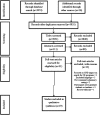A Systematic Review of the Effects of Continuing Education Programs on Providing Clinical Community Pharmacy Services
- PMID: 27402991
- PMCID: PMC4937983
- DOI: 10.5688/ajpe80588
A Systematic Review of the Effects of Continuing Education Programs on Providing Clinical Community Pharmacy Services
Abstract
Objective. To summarize the effects of media methods used in continuing education (CE) programs on providing clinical community pharmacy services and the methods used to evaluate the effectiveness of these programs. Methods. A systematic review was performed using Medline, SciELO, and Scopus databases. The timeline of the search was 1990 to 2013. Searches were conducted in English, Portuguese, and Spanish. Results. Nineteen articles of 3990 were included. Fourteen studies used only one media method, and the live method (n=11) was the most frequent (alone or in combination). Only two studies found that the CE program was ineffective or partially effective; these studies used only the live method. Most studies used nonrobust, nonvalidated, and nonstandardized methods to measure effectiveness. The majority of studies focused on the effect of the CE program on modifying the knowledge and skills of the pharmacists. One study assessed the CE program's benefits to patients or clients. Conclusion. No evidence was obtained regarding which media methods are the most effective. Robust and validated methods, as well as assessment standardization, are required to clearly determine whether a particular media method is effective.
Keywords: community pharmacy; continuing education; pharmacy service.
Figures
References
-
- Paudyal V, Hansford D, Cunningham S, Stewart D. Pharmacy assisted patient self care of minor ailments: a chronological review of UK health policy documents and key events 1997-2010. Health Policy. 2011;101(3):253–259. - PubMed
-
- Berbatis CG, Sunderland VB, Joyce A, Bulsara M, Mills C. Enhanced pharmacy services, barriers and facilitators in Australia’s community pharmacies: Australia’s national pharmacy database project. Int J Pharm Pract. 2007;15(3):185–191.
-
- Christensen DB, Farris KB. Pharmaceutical care in community pharmacies: practice and research in the US. Ann Pharmacother. 2006;40(7-8):1400–1406. - PubMed
-
- Cipolle RJ, Strand LM, Morley PC. Pharmaceutical Care Practice: The Patient-Centered Approach to Medication Management. 2nd edition. New York, NY: McGraw-Hill Medical; 2012.
-
- Storpirts S. Perspectives and challenges in pharmaceutical care. Braz J Pharm Sci. 2012;48(4)
Publication types
MeSH terms
LinkOut - more resources
Full Text Sources
Other Literature Sources


